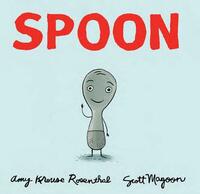Take a photo of a barcode or cover
anthropomorphized kitchen utensils, spoons, forks, etc., family, different talents and abilities
Super cute picture book that so many students will relate to! Spoon feels like everybody has a more exciting life than he does. Little does he know that the cutlery he envies are jealous of what they see him doing. With the help of his mother, he begins to appreciate all of the things he can do and not focus on what he cannot. Recommended for grades K-2.
The store got a collection of new books and Beth handed it to me before I had my games (my department) setup for Summer Break Game Afternoon.
When the book opens you see a collection of frightening spoons. Spoons of all kinds, soup, slotted, grapefruit, and sporks are all represented. The color of the image is dark and menacing. Readers are unable to see clear definition in each spoon which adds to terror of the image. The odd artwork doesn't continue, only the spoons seem to suffer, the fork and chopsticks seem bright and happy.
The plot of the tome is a story which has been told and will be told again, hopefully better than this attempt. The spoon is envious of the other utensils abilities. The small spoon whines though the first half of the book and then we get to the predictable second half where the other utensils make small comments about how lucky the spoon is. Then at the end the small spoon feels so miserable he climbs in bed with his parents. No resolution to the story at all. What happens next? Does the spoon still feel bad? Of course she does, so what does the story teach us? Does it say that life is devoid of hope and the only way to cure it is to find a warm bed?
Jan and Beth, my colleagues, didn't enjoy it either. Beth quickly moved the book from facing out in "Our Favorites" to "New Arrivals". Beth won't be reading it during Story Time.
When the book opens you see a collection of frightening spoons. Spoons of all kinds, soup, slotted, grapefruit, and sporks are all represented. The color of the image is dark and menacing. Readers are unable to see clear definition in each spoon which adds to terror of the image. The odd artwork doesn't continue, only the spoons seem to suffer, the fork and chopsticks seem bright and happy.
The plot of the tome is a story which has been told and will be told again, hopefully better than this attempt. The spoon is envious of the other utensils abilities. The small spoon whines though the first half of the book and then we get to the predictable second half where the other utensils make small comments about how lucky the spoon is. Then at the end the small spoon feels so miserable he climbs in bed with his parents. No resolution to the story at all. What happens next? Does the spoon still feel bad? Of course she does, so what does the story teach us? Does it say that life is devoid of hope and the only way to cure it is to find a warm bed?
Jan and Beth, my colleagues, didn't enjoy it either. Beth quickly moved the book from facing out in "Our Favorites" to "New Arrivals". Beth won't be reading it during Story Time.
I wanted to love this book. It’s such a clever idea, and the pictures are adorable. However, after reading this book I was left thinking that I didn’t get much out of it. Yes, there is the message that we should celebrate our individuality, but there are many more books that do a much better job of communicating that message. I wouldn’t have liked this one at all had it not been for the illustrations. They are clever and original. The faces on the utensils do a great job of personifying them so that readers can better relate to the characters. I enjoy many of Rosenthal’s other books, and would recommend those to readers before this title.
Very sweet book about appreciating and valuing who you are & what you have to offer. And you'll never look at a spoon the same way again. The end is super sweet.
An interesting twist on the "I'm different = I'm not as cool as my friends" theme. Spoon wishes it could cut like Knife, or go everywhere like Fork or be exotic like Chopsticks. But by the end it learns to appreciate the qualities of being a spoon...
This is a great book that I feel can help children express feelings of envy and also teaches appreciating your own strengths and privileges. It can also be used to teach personification. It could be a good way to teach children about positive thinking as well.
Delightful from beginning to end! This would be an excellent text for teaching kids about perspective or POV and could lead into a great writing activity where kids present the pros and cons of being inanimate objects.





